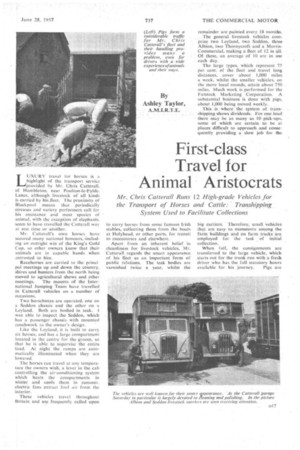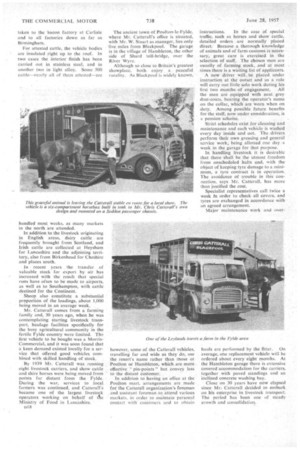First-class Travel for Animal Aristocrats
Page 73

Page 74

If you've noticed an error in this article please click here to report it so we can fix it.
Mr. Chris Catterall Runs 12 High-grade Vehicles for the Transport of Horses and cattle:` Transhipping System Used to Facilitate Collections
By Ashley Taylor,
A.M.I.R.T.E.
LUXURY travel for horses is a highlight of the transport service provided by Mr, Chris Catterall, of 1-lambleton, near Poulton-le-Fylde. Lanes, although livestock of all kinds is carried by his.Ileet. The proximity of Blackpool means that periodically circuses and variety performers call for his assistance and most species of animal, with the exception of elephants. seem to have travelled the Catterall way
at one time or another. .
Mr. Catterall's own horses have secured many national honours, rincluding an outright win of the King's Gold Cup, so other owners know that their animals are in capable hands when entrusted to him.
Racehorses are carried to the principal meetings up and down the country, shires and hunters from the north being moved to agricultural shows and other
meetings. The mounts of the International Jumping Team have travelled in Catterall vehicles on a number of occasions.
Two horseboxes are operated, one on a Seddon chassis and the other on a Leyland. Both are bodied in teak. I was able to inspect the Seddon, which has a passenger chassis With mounted coachwork to the owner's design.
Like the Leyland, it is built to carry six horses, and has a large compartment located in the centre for the groom, so that he is able to supervise the entire load. At night the ramps are automatically illuminated when they are lowered.
The horses can travel at any temperature the owners wish, a lever in the cab controlling the air-conditioning system which heats the compartments in winter and cools them in summer. electric fans extract foul air from the interior.
These vehicles travel throughout Britain and are frequently called upon to carry horses from some famous Irish stables, collecting them from the boats at Holyhead, or other ports, for transit to racecourses and elsewhere.
Apart from an inherent belief in cleanliness for livestock vehicles, Mr. Catterall regards the smart appearance of his fleet as an important form of public relations. The teak bodies are varnished twice a year, whilst the remainder are painted every 18 months.
• The general livestock vehicles comprise two Leyland, two Seddon, three Albion, two Thornycroft and a MorrisCommercial, Making a fleet of 12 in all. Of these, an average of 10 are in use each day.
The large types, which represent 75 per cent. of the fleet and travel long distances, cover about 1,000 miles a week, whilst the smaller vehicles. on the more local rounds, attain about 750 miles. Much work is performed for the Fatstoek Marketing Corporation. A substantial business is done with pigs, about 1,000 being moved weekly.
This. is • where the system of transshipping shows dividends. For one load there May be as many• as 10 pick-ups, some of which arc certain to be at places difficult to approach and consequently providing a slow job for the big carriers: 'Therefore, small vehicles that are easy. to. manceuvre among the farin buildings and on farin tracks are employed for the task . of initial collection.
When full, the consignments are transferred to the large vehicle, which starts out for the trunk run with a fresh driver who has the full statutory hours available for hit journey. Pigs are taken to the bacon factory at Carlisle and to all factories down as far as Birmingham.
For attested cattle, the vehicle bodies are insulated right up to the roof. In two cases the interior finish has been carried out in stainless steel, and in another two in light alloy. Some 500 cattle—nearly all of them attested—are handled most weeks, as many markets in the north are attended.
In addition to the livestock originating in English areas, dairy cattle are frequently brought from Scotland, and Irish cattle are collected at Fleysharn for Lancashire and the adjoining territory, also from Birkenhead for Cheshire and places south.
In • recent years the transfer of valuable stock for export by air has increased with the result that special runs have often to be made to airports, as well as to Southampton, with cattle destined for the Continent.
Sheep also constitute a substantial proportion of the loadings, about 1,000 being moved in an average week.
Mr. Catterall comes from a farming family and, 30 years ago, when he was contemplating starting livestock transport, haulage facilities specifically for the busy agricultural community in the fertile Fylde country were limited. Th first vehicle to be bought was a MorrisCommercial, and it was soon found that a keen demand existed locally for a service that offered good vehicles combined with skilled handling of stock, .
By 1939 Mr. Catterall was running eight livestock carriers, and show cattle and shirt horses were being moved from points far distant from the Fylde. During the war, services to local farmers was continued, and Catterall' became one of the largest livestock operators working on behalf of tike Ministry of Food in Lancashire.
IA 8 The ancient town of Poulton-le-Fylde, where Mr. Catterall's office is situated, with Mr. W. Stuart as manager, lies onlylive miles from Blackpool. The garage is in the village of Hambleton, the other side of Shard toll-bridge, over the River Wyre. .
Although so close to,Britain's greatest showplace, both. enjoy . a peaceful rurality. As Blackpool is widely known, however, some of the Catterall vehicles, travelling far and wide as they do, use the resort's name rather than those or • Poulton o Hambleton, which are more effective pin-points" but convey less to the distant customer.
In addition to having an office at the Poulton mart, arrangements are made for the Catterall organization's foreman and assistant foreman-Jet attend various markets, in order to maintain personal contact with customer's and to obtain instructions. In the case of special
traffic, such as horses and show cattle, detailed orders . are normally placed direct.Because a thorough knowledge of animals and of farm customs is necessary, great care is exercised in the selection of staff. The chosen men are usually of farming stock, and at most times there is a waiting list of applicants.
A new driver will, be pladed under instruction at the outset and as a rule will carry out little solo work during his iirst two months of engagement. All the men are equipped with neat grey dust-coats, bearing the operator's name on the collar, which are worn when on duty. Among possible future benefits for the staff; now under consideration, is a pension scheme.
Strict schedules exist for cleaning and maintenance and each vehicle is washed every day inside and out. The drivers perform their own greasing and general service work, being allotted one day a week in the garage for that purpose.
In handling livestock it is desirable that there shall be the utmost freedom from unscheduled halts and, with the object of keeping tyre damage to a minimum, a tyre contract is in operation. The avoidance of trouble in this connection, says Mr. Catterall, has more than justified the cost.
Specialist representatives call twice a week it order to check all covers, and tyres are exchanged in accordance with an agreed arrangement.
Major maintenance work and over
hauls are performed by the fitter. On average, ohe replacement vehicle will be ordered about every eight months. At the Hambleton garage there is extensive covered accommodation for the carriers. together with paved standings and an inclined concrete washing bay.
Close on 30 years have now elapsed since Mr: Catterall decided to embark on his enterprise in livestock transport. The period has been one of steady growth and consolidation.








































































































































